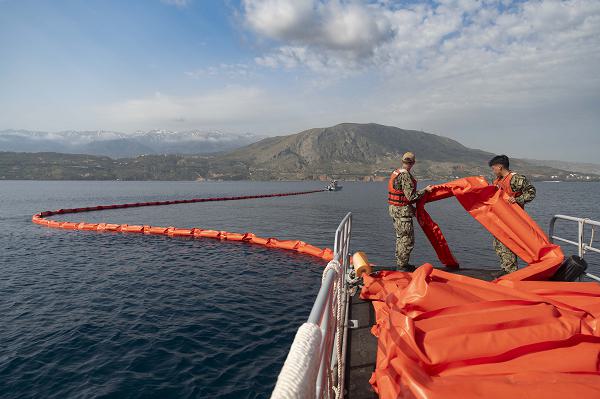
Souda Bay, Greece. (April 19, 2024): In an oil spill disaster, seconds count for Navy authorities trying to limit the ecological damage. In this photo by Petty Officer 1st Class Delaney S. Jensen, Petty Officer 2nd Class Sean Sweetay and Seaman Apprentice Tencing Wang Po practice deploying an oil boom during a spill prevention and response training exercise. These highly skilled Sailors deploy a variety of “booms” that use different methods to corral and contain a spill. These booms use mooring systems, such as anchors or landlines, which can be maneuvered to close off sensitive habitat or to divert the oil away. The three booms at their disposal are:
The Hard boom: This is a floating piece of plastic that contains floats on top and weights on the bottom to form a “skirt” under the water. If the currents or winds are not too strong, the Hard boom can collect and divert oil spills away from coastal areas.
The next tool available to oil spill responders is the Sorbent boom. This device looks like a huge log made out of cloth material that absorbs oil. The Sorbent booms don't have the "skirt" that Hard booms have so they can't contain oil for very long.
The third collection device is the Fire boom, a series of metal plates that form the “skirt” and designed to corral the oil long enough to be lit on fire and burned off. This “burning in place" of an oil slick is controversial due to its potential effects on wildlife. For this reason, Fire booms are seldom used and only during ideal conditions when the weather is relatively calm.
Each of these booms are assisted by “Skimmers,” boats specifically equipped to remove oil from the sea surface. Lastly, the Navy uses aircraft or boats to apply dispersants (chemicals that disperse the oil into the water column) to cause the oil to sink to the bottom where it is less likely to affect beaches or tidal flats.
Americans can be assured the Navy will be ready to “lower the boom” should an oil spill occur.


